Program 12
A Million Prayers for Amitabha Buddha and the Lion Dance of Yozuku
(Yozuku no hyakumanben nenbutsu shishimai)- 1971 / Color / Digital File (Original: 16mm) / 25 min
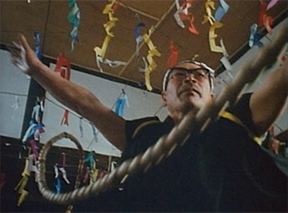 Director: Noda Shinkichi
Director: Noda Shinkichi
Photography: Suzuki Masami, Kanai Katsu
Music: Sukegawa Toshiya
Narrator: Takashima Akira
Planning: Kanagawa Prefectural Government Education Bureau
Production Company: Kanagawa News Film Association
Source: Kanagawa Prefecture
In Yamakita, a town in the Ashigarakami District of Kanagawa Prefecture, there is a nenbutsu chanting practice associated with the Noanji Soto Zen temple that has a history of approximately 600 years. The nenbutsu is chanted as men rotate a large strand of 302 prayer beads affixed around a pulley. This is followed by a lion dance (shishimai) that proceeds around all the houses of the village as a purification ritual.
Yoshihama’s Kashima Dance, Ashigara’s Sasara Dance
(Yoshihama no kashimaodori / Ashigara sasaraodori)- 1971 / Color / Digital File (Original: 16mm) / 32 min
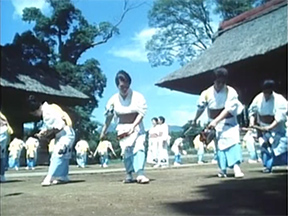 Director: Noda Shinkichi
Director: Noda Shinkichi
Photography: Fujioka Susumu, Tanaka Shigeru, Kanai Katsu, Ishii Jinsei
Music: Hara Masami
Planning: Kanagawa Prefectural Government Education Bureau
Supervisor: Nagata Koukichi
Producer: Inoue Shuzo
Production Company: Kanagawa News Film Association
Source: Kanagawa Prefecture
The Kashima Dance is performed in the area of Kanagawa Prefecture extending from Odawara City along the western shore of Sagami Bay. This film documents a dedication of the dance on the grounds of Yoshihama’s Soga Shrine performed in August by twenty-five people. The film also records the Sasara women’s dance which the women’s association and the elders of Minami Ashigara City in the west of Kanagawa Prefecture revived after a fifty-year hiatus.
The Lion Dance of Toya
(Toya no shishimai)- 1972 / Color / Digital File (Original: 16mm) / 16 min
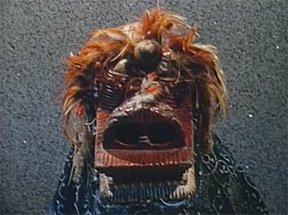 Director: Noda Shinkichi
Director: Noda Shinkichi
Photography: Kanai Katsu, Kosaka Masataka, Hosoi Yasuaki
Planning: Kanagawa Prefectural Government Education Bureau
Producer: Inoue Shuzo
Production Company: Kanagawa News Film Association
Source: Kanagawa Prefecture
A folk festival with a three-hundred-year history held at Suwa Shrine in Toya in Sagamihara City’s Midori Ward, Kanagawa Prefecture. Within the shrine grounds, a father, mother, and child lion line up and dance to the sound of flutes and singing. As a prayer dance that retains a simplicity passed down since the 17th century, it is unique in Japan.
Miura Kikuna’s Ameya Dance
(Miura Kikuna no ameyaodori)- 1972 / Color / Digital File (Original: 16mm) / 12 min
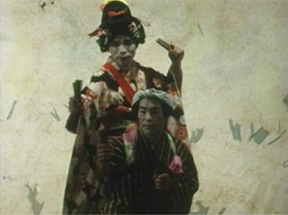 Director: Noda Shinkichi
Director: Noda Shinkichi
Planning: Kanagawa Prefectural Board of Education
Production Company: Kanagawa News Film Association
Source: Kanagawa Prefecture
Located on Kanagawa Prefecture’s Miura Peninsula, Kikuna bustles with beachgoers in the summer. In October, the Miura Shirayama Shrine holds an annual festival, the Ameya dance, which has a history extending to the late Edo Period. Young men dressed in female garb perform dances including the shiramatsu konaya, komori, and godanme. The film emphasizes the wild aspect of these performing arts birthed by struggling farmers and fishermen.
Sagicho in Oiso
(Oiso no sagicho)- 1972 / Color / Digital File (Original: 16mm) / 14 min
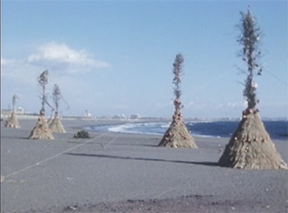 Director: Noda Shinkichi
Director: Noda Shinkichi
Planning: Kanagawa Prefectural Board of Education
Supervisor: Nagata Koukichi, Goto Hajime
Production Company: Kanagawa News Film Association
Production Support: Oiso Sagicho Preservation Society
Source: Kanagawa Prefecture
This film documents the Sagicho Fire Festival, which takes place in the eight communities constituting Oiso, a town located in the warm climate along Kanagawa Prefecture’s Sagami Bay. It begins at the year’s end with an event in which children take the lead. With the new year, an okariya shelter is constructed in town for the dosojin guardian god. Then, saito bonfire structures are burned on the beach and young men perform a tug of war in the water.
The Horse-running Ritual of Honmoku Shrine
(Honmoku no oumanagashi)- 1973 / Color / Digital File (Original: 16mm) / 13 min
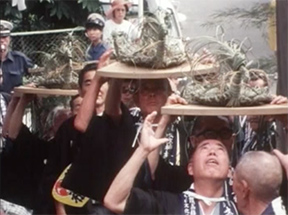 Director: Noda Shinkichi
Director: Noda Shinkichi
Planning: Kanagawa Prefectural Board of Education
Production Company: Kanagawa News Film Association
Source: Kanagawa Prefecture
For four hundred years, the Honmoku Shrine in Yokohama’s Naka Ward has hosted the Oumanagashi Horse Running Festival to ward off evil. The day before the festival, ouma horse figures made from sedge grass and placed on boards are passed overhead by shrine parishioners dressed in formal costume until they enter the shrine. On the day of the festival, the ouma are paraded through the streets, then transferred to festival boats, floated out, and abandoned to the sea.
